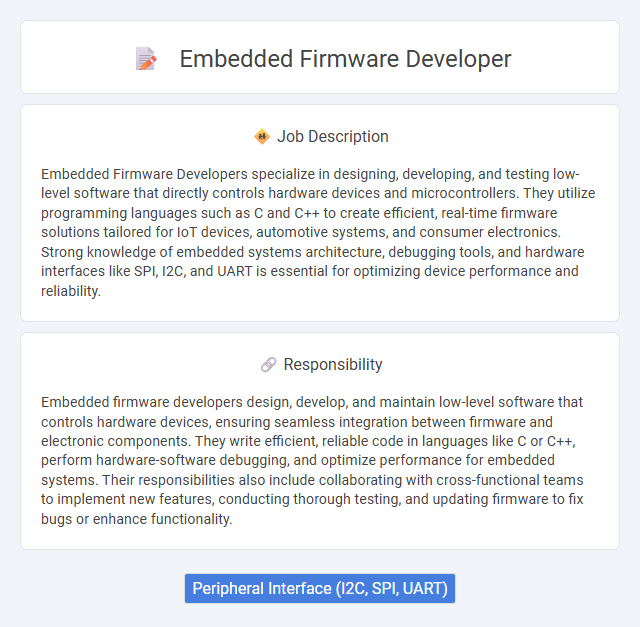
Embedded Firmware Developers specialize in designing, developing, and testing low-level software that directly controls hardware devices and microcontrollers. They utilize programming languages such as C and C++ to create efficient, real-time firmware solutions tailored for IoT devices, automotive systems, and consumer electronics. Strong knowledge of embedded systems architecture, debugging tools, and hardware interfaces like SPI, I2C, and UART is essential for optimizing device performance and reliability.
Individuals with strong problem-solving skills and a passion for low-level programming are likely suitable for an Embedded Firmware Developer role. Those comfortable with working in detailed, hardware-oriented environments may find this job aligns well with their strengths. People who prefer fast-paced, high-level application development might face challenges adjusting to the intricacies of embedded systems.
Qualification
Embedded Firmware Developers require strong proficiency in C/C++ programming and deep understanding of microcontroller architectures such as ARM Cortex-M or AVR. Expertise in real-time operating systems (RTOS), hardware-software integration, and debugging tools like JTAG and oscilloscope is essential. A degree in Electrical Engineering, Computer Science, or related fields, combined with experience in low-level hardware interfaces and communication protocols like SPI, I2C, and UART, is highly preferred.
Responsibility
Embedded firmware developers design, develop, and maintain low-level software that controls hardware devices, ensuring seamless integration between firmware and electronic components. They write efficient, reliable code in languages like C or C++, perform hardware-software debugging, and optimize performance for embedded systems. Their responsibilities also include collaborating with cross-functional teams to implement new features, conducting thorough testing, and updating firmware to fix bugs or enhance functionality.
Benefit
Embedded Firmware Developers likely enjoy benefits such as competitive salaries and opportunities for continuous skill advancement in cutting-edge technologies. There is a strong probability of working in innovative industries like automotive, aerospace, or IoT, which may offer job stability and growth potential. Employers might also provide flexible work environments and access to specialized tools, enhancing both productivity and job satisfaction.
Challenge
Embedded firmware developer roles likely involve complex problem-solving tasks due to the integration of hardware and software components. The challenge probably centers on optimizing performance and ensuring system reliability within constrained environments. Adapting to rapidly evolving technologies and debugging low-level code may frequently test one's technical skills and creativity.
Career Advancement
Embedded Firmware Developers possess specialized skills in programming low-level hardware interfaces crucial for IoT, automotive, and consumer electronics industries. Career advancement often involves mastering real-time operating systems, proficiency in C/C++ programming, and gaining expertise in hardware debugging and system architecture. Progression can lead to roles such as Senior Firmware Engineer, Embedded Systems Architect, or Technical Lead, driving innovation and overseeing complex embedded projects.
Key Terms
Peripheral Interface (I2C, SPI, UART)
Embedded Firmware Developers specialize in designing and implementing software that controls hardware peripherals such as I2C, SPI, and UART interfaces, ensuring efficient communication between microcontrollers and external devices. Expertise in these serial communication protocols enables seamless integration and optimization of sensor data acquisition, memory storage, and real-time device control within embedded systems. Proficiency in low-level programming languages like C and assembly facilitates precise management of hardware registers and interrupt handling critical for reliable peripheral interface operation.
 kuljobs.com
kuljobs.com